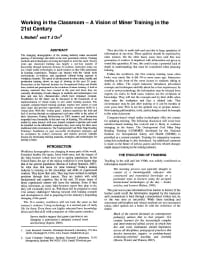Mining Publication: Working in the Classroom - A Vision of Miner Training in the 21st Century
Original creation date: November 2008
Authors: LG Mallett, TJ Orr
NIOSHTIC2 Number: 20034787
Proceedings of the First International Future Mining Conference and Exhibition 2008 (Sydney, New South Wales, Australia, November 19-21, 2008). Carlton, Victoria, Australia: Australasian Institute of Mining and Metallurgy, pp. 83-89
The changing demographics of the mining industry make successful passing of knowledge and skills to the next generation critical. Training methods and technologies are being developed to meet this need. Twenty years ago classroom training was largely a one-way transfer of knowledge through instructor lectures. In contrast, instructors today can use virtual reality technologies to guide trainees as they fully participate in learning experiences. Trainees can interact with the virtual work environment, co-workers, and equipment without being exposed to workplace hazards. The speed of advancement in mine safety, health, and production training shows no sign of slowing in the next 20 years. Researchers at the National Institute for Occupational Safety and Health have studied and participated in the evolution of miner training. A look at training materials they have created in the past and those they are currently developing reveals changes in methods and technologies over time and also key characteristics which have remained constant. Possibilities for the future can be discussed in the framework of an implementation of virtual reality in new miner training sessions. The example computer-based training package teaches new miners to read mine maps and provides opportunity to practice navigation skills in a virtual mine. With this serious game, trainees experience the look and feel of moving through an underground coal mine while in the safety of their classroom. During field-testing in 2007, trainees and instructors responded very favourably to this new way of learning. The software was usable by mine trainers with even limited computer expertise and could be installed on the affordable computers they were using for their more traditional slide presentations. The Underground Coal Mine Map Reading Training is based on past successful development strategies and its acceptance by today's instructors and trainees provide valuable lessons for developing training materials, strategies, and technologies for the future of mining.

NIOSHTIC2 Number: 20034787
Proceedings of the First International Future Mining Conference and Exhibition 2008 (Sydney, New South Wales, Australia, November 19-21, 2008). Carlton, Victoria, Australia: Australasian Institute of Mining and Metallurgy, pp. 83-89
- Developing Toolbox Training Materials for Mining
- Education and Training
- An Ounce of Prevention: Training Workers to Prevent a Crisis
- An Overview of Technology and Training Simulations for Mine Rescue Teams
- An Overview of the Evaluation Process for Mine Trainers
- A Performance Approach to Training Research
- Technology News 513 - Coaching Workshop for On-the-Job Trainers
- Tell Me A Story... Using Stories to Improve Occupational Safety Training
- Tell Me a Story: Using Narrative to Teach Safety to Skilled Blue-Collar Workers
- Tell Me a Story: Using Stories to Improve Occupational Safety Training
- Tell Me a Story: Why Stories are Essential to Effective Safety Training